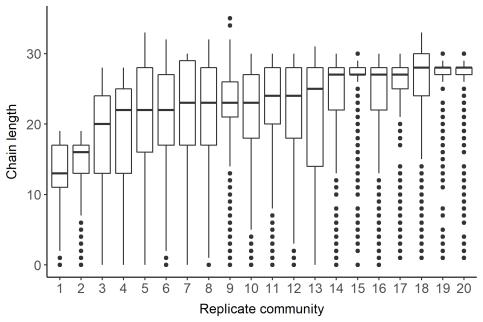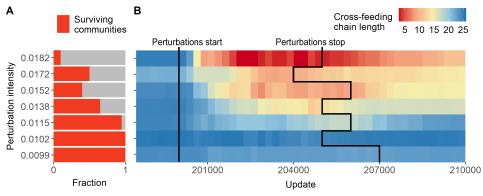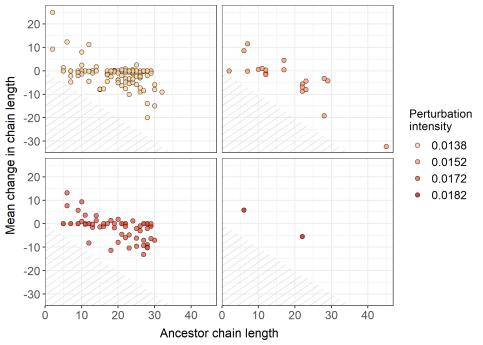Findings & conclusion
Cross-feeding chain length in an unperturbed environment

In an unperturbed environment, cross-feeding chains often reached 30 steps or more, showing that there were no inherent constraints to evolving very long chains of byproduct cross-feeding. It is important to remember that, in the experimental environment, there is no energy loss between trophic levels, which is a well-known constraint of food chains [1]. Therefore, it is not necessarily realistic to expect quite so long chains to appear in nature.
The effects of perturbations

Some communities went extinct because of the perturbations (Figure 2A). Among the surviving communities, perturbations regularly caused cross-feeding chains to shorten, especially if perturbation intensity (a joined measure of perturbation magnitude and rate) was high (Figure 2B). In some communities, effects even persisted after perturbations had stopped.
In Figure 2B, each row represents the mean of surviving replicates in a single experiment. Perturbation intenstiy is shown on the y-axis, and experiment time on the x-axis. The black lines mark where the perturbation period started and ended, and color shows chain length (mean of median in surviving replicates).
Evolution of cross-feeding chains

To start investigating why cross-feeding chains shortened, I wanted to see if it was possible that the perturbations caused an evolutionary loss of the ability to consume resources low in the byproduct chain. That is, was it an evolutionary adaptation to shorten cross-feeding chains?
In Figure 3, the y-axis shows the mean change in chain length between an ancestor born before perturbations and its descendants born after perturbations. If the value is positive, descendants have longer chains than the ancestor, and if it is negative, descendants have shorter chains. The x-axis shows ancestor chain length.
The slope visible among the points show that the longer chain an ancestor had, the more its descendants decreased their chain length, and the shorter chain an ancestor had, the more its descendants increased their chain length. Thus, the result suggests that perturbations caused organisms descending from long-chained ancestors to evolve a shorter cross-feeding chain. The evolutionary loss of abilities to consume low-level resources could explain the presisting effects on cross-feeding chains after perturbations stopped - it simply takes a while for the abilities to evolve anew.
Conclusion
Recurring perturbations have potential to constrain the length of cross-feeding chains in environments with complete energy transfer between trophic levels. In communities of digital organisms, cross-feeding chains commonly reached 30 steps or more, which is one order of magnitude longer than the average chain length in the human gut. When exposing these communities to recurring perturbations, cross-feeding chains regularly shortened, especially when perturbations were strong or frequent. Some evidence suggests that organisms adapted to recurring perturbations by losing the ability to consume resources late in the byproduct chain, which could explain the persisting effects on chain length observed in some communities after perturbations stopped. While it is evident that perturbations constrain cross-feeding chains in this environment, further experiments, for example on effects of energy loss between trophic levels, are needed to expand conclusions to biological systems, such as the gut microbiome. It is also necessary to investigate under which circumstances perturbations have an effect and not
Continue to Downloads or Contact information.
References
- Hutchinson, G. E., 1959. Homage to Santa Rosalia, or why are there so many kinds of animals? American Naturalist 93 (870), 137–145.
Responsible for this page:
Director of undergraduate studies Biology
Last updated:
05/28/21
